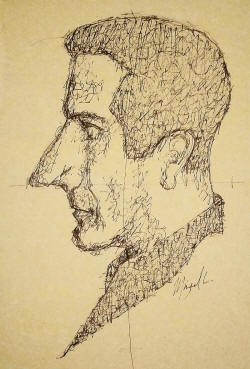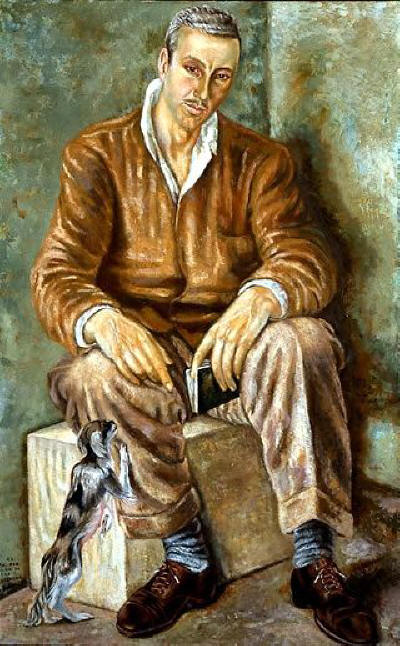

Partner Diego de Mesa, Marek Keller
Queer Places:
Centro Cultural Juan Soriano, C. Dr. A. Nápoles Gandara, Amatitlán, 62410 Cuernavaca, Mor., Mexico
 Juan Soriano (born Juan Francisco Rodríguez Montoya; August 18, 1920 – February 10, 2006) was a Mexican artist known for his paintings, sculptures and theater work. He was a child prodigy whose career began early as did his fame with various writers authoring works about him. He exhibited in the United States and Europe as well as major venues in Mexico such as the Museo de Arte Moderno and the Palacio de Bellas Artes. His monumental sculptures can be found in various parts of Mexico and in Europe as well. Recognitions of his work include Mexico's National Art Prize, the Chevalier des Arts et Lettres and membership in France's Legion of Honour.
Juan Soriano (born Juan Francisco Rodríguez Montoya; August 18, 1920 – February 10, 2006) was a Mexican artist known for his paintings, sculptures and theater work. He was a child prodigy whose career began early as did his fame with various writers authoring works about him. He exhibited in the United States and Europe as well as major venues in Mexico such as the Museo de Arte Moderno and the Palacio de Bellas Artes. His monumental sculptures can be found in various parts of Mexico and in Europe as well. Recognitions of his work include Mexico's National Art Prize, the Chevalier des Arts et Lettres and membership in France's Legion of Honour.
Alberto Misrachi sold homophile books and magazines from his foreign-language bookstore, ‘Librerıa Misrachi’ (1939–92) on Avenida Juarez, across the street from ‘Librerıa Cristal’. Misrachi had an art gallery attached to his business and sold – mostly to tourists – the works of leading Mexican painters, including many gays like Roberto Montenegro, Jesús Reyes Ferreira and Soriano.
Same-sex-attracted men developed an affinity for domestic tasks – cleaning, grocery shopping, cooking – that allowed them to care for each other, performing the work otherwise assigned to servants in households of their status. But that is not to say that these men had developed some sort of revolutionary conscience and solidarity with workers. Rather, they learned to derive pleasure from taking care of each other, as eloquently articulated in Salvador Novo’s letters to Carlos. And, for less intimate quotidian tasks, they hired working-class same-sex-attracted men as well as heterosexual servants who frequently also cared for older parents and unwed siblings present in the household headed by a gay man and his partner. Juan Soriano noted how, in the absence of his two-decade-long partner Diego de Mesa, Mesa’s mother would defer all major decisions to Soriano, regarding her son’s partner as the head of household. The success and autonomy of gay households thus depended greatly on their trusted staff and the extended family. Drawing from within their gay social networks, they hired working-class queers they or their acquaintances had met at bars, parties or cruising grounds, to work in their homes. Working-class same-sex-attracted men thus found opportunity by becoming the personal valet, cook, gardener or driver of affluent gays. Similarly, gay purveyors and service providers – such as architects, designers, decorators, caterers and antique dealers – also benefited from the large numbers of gay households, frequently showing off their work to potential clients.


Soriano, Juan (1920-2006) - 1948 Portrait of Diego de Mesa with Dog (Private Collection)

Portrait of Xavier Villaurrutia (1940)
Juan Soriano
Soriano was born Juan Francisco Rodríguez Montoya in Guadalajara to Rafael Rodríguez Soriano and Amalia Montoya Navarro.[1] Starting in childhood he began to call himself Juan Soriano, preferring the maternal surname of his father.[2] He described his family of origin as “eccentric.”[3] He was a child prodigy, and in 1933, his sister introduced him to painter Alfonso Michel Martínez who taught him current modes of Expressionist and neo Baroque painting. He then studied under Francisco Rodríguez “Caracalla” at the Evolución Studio in Guadalajara, which also trained Raúl Anguiano and Jesús Guerrero Galván.[1][4] At this time he was also a regular visitor to the home and business of Jesús Reyes Ferreira. Reyes gave him work in his shop to make decorated wrapping paper as he did but Soriano found the work difficult.[5] However, the time here allowed him to meet creators such as Luis Barragán and Roberto Montenegro, experience European art in books and magazines and discover portraits by José María Estrada, which Reyes collected. Soriano also went to his first museum and began to read classic books edited by José Vasconcelos.[2][6] His first exhibition of his work allowed him to meet artists such as José Chávez Morado, Lola Álvarez Bravo and María Izquierdo, who encouraged him to move to Mexico City, which he did in 1935 at the age of fifteen, along with his sister Martha.[1][5] Here he continued a lifelong cultivation of friendships with artists, writers and intellectuals, which Soriano stated was one of the main treasures of his life.[3] These included Xavier Villaurrutia, Carlos Pellicer, Octavio Paz (who wrote several essays about him), Lola and Manuel Álvarez Bravo, Rafael Solana (with whom he traveled to UC Berkeley in 1938), Isabel Villaseñor, Frida Kahlo, Lupe Marín and Salvador Novo.[4][6] He was part of a regular social circle with Octavio G. Barreda as part of his love for poetry and writing, becoming involved in magazines such as El hijo prodigo and La Revista de la Universidad de México.[2][6] Soriano visited Rome for the first time in 1952 and in 1954 visited Crete where he painted Apolo y las musas. He returned to Rome again to live from 1969 to 1975, which allowed him to study classical art.[4][6] In 1963 he suffered an automobile accident which he documented in a painting called El accidente.[6]
In 1974, Soriano met Polish dancer Marek Keller on a visit to Paris, introduced by writer Sergio Pitol. This was the beginning of an over thirty-year relationship. Soriano worked incessantly and cared only about his work, leaving the rest of his affairs in disorder. Keller stepped in to manage most of these and put some order in the artist's life. The two remained together, living in both Mexico City and Paris until Soriano's death.[3] Since then, Keller has worked to promote the artist's legacy in various parts of the world.[7] Juan Soriano died in 2006 at the age of 85 at the Instituto Nacional de Nutrición Salvador Zubirán in Mexico City from multiple causes.[1]
My published books: